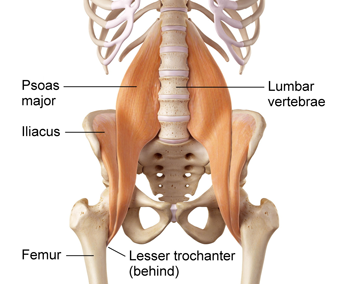The Psoas Muscle.
The Psoas muscle is a muscle that seats in the Lumbar region of the body. It is palpable through the abdominal region when the client is in the supine position.
Psoas Muscle is often related to and taken into consideration with iliacus muscle, as those 2 muscles share the insertion tendon and point. For this reason, they get called Iliopsoas Muscle.
Origin, Insertion, and Action of the Psoas Muscle:
- Origin: Body and Transverse process of the Lumbar Vertebrae (L1-L5)
- Insertion: Lesser Trochanter of the Femur
- Action:
- with the Origin fixed:
- flex the hip
- externally rotate the hip
- with the Insertion fixed:
- flex the trunk towards the tight
- tilt the pelvis anteriorly
- flex the vertebral column laterally.
- with the Origin fixed:
- Innervation is supplied from the anterior rami of spinal nerve L1-L3
- Blood Supply from the lumbar branch of the iliolumbar artery
The Psoas muscle has a reference pattern that involved the abdominal area but even the front of the tight.
It is often tight for people who spend a lot of time seating on a chair, like office workers and or who drive for long hours. This happens because the muscle is in constant contraction when we spend time seating.
On the other hand, the Psoas Muscle is often also related to emotional distress.
This can happen because when we live with negative emotions we tend to contract the abdominal area and tight the muscle-up, especially for reaching out a fetal position, which recalls maternity safety.
By analyzing the action of this muscle, it is easy to notice how is involved in assuming a fetal position, as it is a hip flexor.
In fact, it contracts the 2 limbs, the upper and lower to gain one with each other.
Treating the Psoas Muscle directly is not always recommended as direct work unless the person has been going through a series of treatments already. This is because where the muscle is lying it is a sensitive spot to access and as it holds a lot of tension, can be a bit sensitive to the touch.
In need of a massage? Book now your next appointment, at Melbourne Massage and Treatment home based clinic.
To treat the Psoas Muscle the client is lying in a supine position.
Firstly we identify the muscle. For doing so after the client did lie in the supine position, the therapist will place her/his hands off the rectus abdominis, on its lat. border, and will create resistance on the client’s tight as it goes for active flexion.
With the hand seating next to the rectus abdominal area, the therapist can feel the muscle activating.
Once the Psoas has been isolated, the therapist can place both hands or one on the muscle, asking the client to breath-in deeply as is flexing the knee (foot running along the table) and as the client’s breath out (it is important here following the breathing wave) the therapist can apply a force straight down.
Furthermore, to ensure that we can release tension from the Psoas Muscle, we have to work on the muscle surrounding it, like the other muscle that holds the same Origin/Insertion patterns, like:
- Erectus Spinae group,
- Quadratus Lumborum,
- Quods
- Hamstring
In fact, the psoas muscle can be involved in presentations such as lower cross syndrome (LCS).
Are you struggling with pain and or body ache? Book now your next massage appointment, at Fitzroy North clinic.
Often as therapists, we would work on the surrounding muscle before doing direct work on the Psoas. This is because direct work in such a sensitive area can be too intense to start with and could make the client feel vulnerable or uncomfortable.
A good exercise to keep the Psoas muscle in shape is a daily walk, even though for a nice and balanced walk we want to make sure to have a correct Extension Leg Firing Pattern.